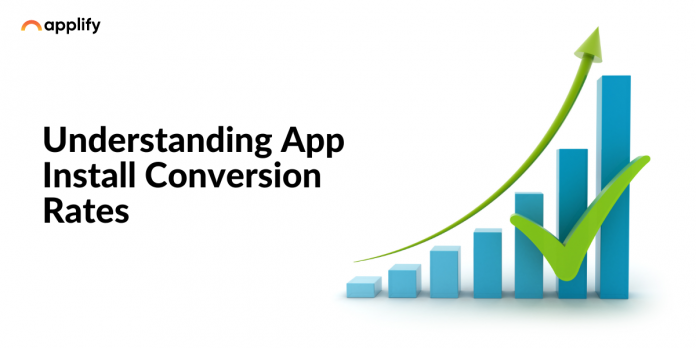As the number of mobile app users continues to grow, app installs conversion rates have become a crucial metric to measure the success of a mobile app advertising campaign. But what is it and how can it be calculated are some of the frequently asked questions. In this article, we will discuss everything about app install conversion rates.
What Are App Install Conversion Rates?
App install conversion rates are a crucial metric that helps app developers and marketers measure the effectiveness of their app advertising campaigns. It is the percentage of users who installed the app after clicking on an ad. A high conversion rate indicates that the ad has successfully attracted users to download the app. While a low conversion rate suggests that the ad may need to be improved or re-evaluated.
For instance, if your app has 1,000 users and 100 of them complete a form submission, the conversion rate would be 10%. This means that 10% of the total app users successfully accomplished the desired action of submitting a form.
Tracking the app install conversion rate is crucial for app developers and businesses as it provides insights into user behavior, engagement, and the overall success of the app in driving desired actions. By analyzing this rate, you can identify areas of improvement, optimize the user experience, and enhance the app’s performance.
Monitoring the conversion rate over time allows you to measure the impact of changes, updates, or marketing campaigns, enabling you to refine strategies and achieve better results. By continually improving the app’s conversion rate, you can maximize user engagement, satisfaction, and the attainment of desired goals.
Understanding and optimizing the mobile app conversion rate empowers developers and businesses to make data-driven decisions, enhance the app’s user journey, and ultimately drive more conversions. It enables you to identify and address any barriers or friction points within the app, leading to improved user experience and increased success in accomplishing conversion objectives.
Types of App Conversion Rate
In the realm of mobile app/digital product development, various types of app install conversions can occur, indicating specific user actions or behaviors within the app. Understanding these different types of mobile app conversions is crucial for app developers and businesses to optimize their strategies and enhance user engagement. Let’s explore some common types of mobile app conversions:
1. Purchase Conversion
This conversion type signifies when a user successfully completes a purchase within the app. It could involve buying a product, subscribing to a service, or making an in-app transaction. For example, a user purchasing a premium subscription in a music streaming app or buying virtual goods in a gaming app.
2. Signup or Registration Conversion
Signup conversions occur when users create an account or register within the app. This action allows users to access personalized features and enables businesses to gather user data for targeted marketing and personalized experiences. An example would be a user signing up with their email address and creating a profile on a social networking app.
3. Form Submission Conversion
Form submission conversions happen when users complete and submit a form within the app. This could be for various purposes, such as providing feedback, participating in surveys, or requesting information. For instance, a user fills out a feedback form within a productivity app.
4. App Download Conversion
App download conversion rate represents the successful installation of the app onto a user’s device. It indicates the initial step of user acquisition. For example, when a user downloads a gaming app from an app store onto their smartphone.
5. In-App Event Conversion
In-app event conversions occur when users perform specific actions or events within the app. These events could be completing a level in a game, adding items to a wishlist, or sharing content on social media. An example would be a user sharing a photo from a photography app to their Instagram feed.
6. Engagement Conversion
Engagement conversions measure user interactions and engagement within the app. It could involve actions such as spending a certain amount of time in the app, viewing a specific number of pages, or performing a sequence of actions. For instance, a user spends 10 minutes exploring different recipes within a cooking app.
Understanding the various types of mobile app conversions helps businesses tailor their strategies to drive specific user behaviors and achieve their desired goals. By optimizing the user experience, implementing effective marketing techniques, and tracking these conversions, app developers can enhance user engagement, increase revenue, and improve the overall success of their mobile applications.
Boost your downloads by reading our comprehensive guide on how to market your app.
How to Increase App Install Conversion Rate?

Increasing the app conversion rate is a crucial objective for app developers and businesses aiming to optimize user engagement, drive more conversions, and maximize the success of their mobile applications. Here are some effective strategies to boost your app’s conversion rate:
1. Enhance User Experience
Provide a seamless and intuitive user experience by focusing on clear navigation, intuitive design, and smooth functionality. Optimize app performance to ensure fast loading times and minimize crashes. For example, the popular navigation app, Waze, improved its conversion rate by offering a user-friendly interface and real-time traffic updates.
2. Optimize App Store Listings
Optimize your app’s presence on app stores by crafting compelling visuals, engaging descriptions, and using relevant keywords. Highlight unique features and benefits to attract potential users. For instance, the language learning app, Duolingo, experienced a significant increase in app install conversion rates by optimizing its app store listing and emphasizing its gamified learning experience.
3. Implement Effective App Onboarding
Guide new users through a well-designed onboarding process that showcases the app’s value and functionality. Provide clear instructions and demonstrate key features. Airbnb’s onboarding process, which guides users through creating a profile, searching for listings, and making a booking, has contributed to its high conversion rate.
4. Utilize Persuasive Call-to-Actions (CTAs)
Use persuasive and visually appealing CTAs strategically placed within the app to encourage users to take desired actions. The ride-hailing app, Uber, effectively uses CTAs to prompt users to request a ride, resulting in higher app install conversion rates.
5. Leverage Social Proof
Incorporate social proof elements such as ratings, reviews, testimonials, and user-generated content to build trust and credibility. Positive reviews and ratings can significantly influence potential users’ decision to download or engage with the app. For example, TripAdvisor leverages user reviews and ratings to increase trust and conversions.
6. Targeted Advertising and App Install Campaigns
Create targeted advertising campaigns to reach your ideal audience through channels such as social media platforms, search engines, and app install networks. Tailor your messaging and visuals to resonate with your target demographic. Airbnb’s targeted advertising campaigns on Facebook and Instagram effectively increased its app install conversion rate among travel enthusiasts.
7. App Store Optimization (ASO)
Optimize your app store presence by conducting thorough keyword research and incorporating relevant keywords in the app title, description, and metadata. This helps improve visibility in app store search results and drives organic installs. For example, the language learning app, Babbel, strategically incorporates relevant keywords to enhance its app store optimization and increase install conversion rates.
Best Practices
- Conduct A/B testing to experiment with different designs, copywriting, and features to identify what resonates best with your target audience.
- Implement personalization and segmentation strategies to deliver tailored experiences to users, increasing their likelihood of converting. Netflix’s personalized recommendations and curated content contribute to its high conversion rate.
- Regularly analyze user feedback, app analytics, and conversion funnel data to identify areas for improvement and optimize the conversion process.
- Optimize the app’s performance and loading times to minimize user frustration and increase the likelihood of conversions.
- Offer incentives, discounts, or rewards to incentivize users to take desired actions. The food delivery app, DoorDash, utilizes promo codes and discounts to encourage users to make their first order.
By implementing these strategies and following best practices, you can effectively increase your app’s conversion rate, attract and retain more users, and drive the success of your mobile application. Remember to continually analyze and adapt your approach based on user feedback and data insights to optimize conversion rates further.
Read your detailed blog on how to advertise your app for an in-depth understanding of app marketing.
How Does App Conversion Rate Affect App Store Ranking?
| App Conversion Rate | App Store Ranking |
|---|---|
| High (above 5%) | Higher |
| Moderate (2-5%) | Moderate |
| Low (below 2%) | Lower |
The app conversion rate plays a significant role in determining the app store ranking of mobile applications. App store ranking algorithms, such as those used by the Apple App Store and Google Play Store, consider various factors, including the conversion rate, when determining an app’s visibility and position in search results. Here’s an explanation of how the app conversion rate affects app store ranking, along with relevant examples and statistics:
1. User Engagement Signals
App stores prioritize apps that have higher user engagement and conversion rates. When users frequently download and engage with an app after finding it through search results or app store listings, it signals to the algorithm that the app is relevant and valuable. This, in turn, improves the app’s chances of ranking higher in search results and category rankings.
Example: A study by Tune revealed that higher conversion rates positively correlate with better app store rankings. The research found that apps with conversion rates above 5% tend to rank significantly higher in search results compared to those with lower conversion rates.
2. Ratings and Reviews
Positive ratings and reviews from users are other important aspects of app store rankings. Higher conversion rates often indicate satisfied users who are more likely to leave positive reviews and ratings. App stores consider the overall sentiment and quality of reviews when determining app rankings.
Example: According to a study conducted by Apptentive, apps with higher conversion rates tend to receive more positive ratings and reviews. The research found that apps with conversion rates above 20% have an average rating of 4.2 or higher, indicating a strong correlation between high conversion rates and positive user sentiment.
3. User Retention and Lifetime Value
App stores value apps that not only acquire new users but also retain them and generate long-term value. Higher app install conversion rates imply that users find value in the app and are more likely to continue using it, leading to increased user retention and higher lifetime value.
Example: A case study by Adjust demonstrated that apps with higher conversion rates experience better user retention. The study found that apps with conversion rates above 10% have a 30% higher retention rate after 30 days compared to apps with lower conversion rates.
Benchmarks for App Store Conversion Rate
App Store conversion rate benchmarks refer to the industry-standard or average conversion rates observed for mobile applications on app stores. These benchmarks provide app developers and businesses with a reference point to evaluate their own conversion rates and assess their performance relative to the industry. Understanding these benchmarks is crucial for setting realistic expectations, identifying areas for improvement, and optimizing app store conversion strategies. Let’s delve into this section with relevant statistics and examples:
1. Overall Conversion Rate Benchmark
The overall conversion rate benchmark represents the average conversion rate observed across all types of apps on app stores. While specific conversion rates may vary depending on factors such as app category, target audience, and app quality, a commonly cited benchmark falls in the range of 2-5%.
Example: According to data from AppsFlyer, the average conversion rate for non-gaming apps on iOS in 2020 stood at approximately 4.5%. This means that, on average, around 4.5% of users who visited an app store listing proceeded to install the app.
2. Category-Specific Conversion Rate Benchmarks
Different app categories can exhibit varying conversion rates due to factors such as user intent, competition, and the nature of the apps themselves. It is essential to consider category-specific benchmarks to gain more accurate insights into how your app performs relative to similar apps in your category.
Example: According to data from Storemaven, shopping apps had an average conversion rate of approximately 7.6%, while social networking apps averaged around 3.3%. These benchmarks highlight the variability in conversion rates across different app categories.
3. Benchmarking Against Competitors
Analyzing the conversion rates of competitor apps within your category can provide valuable insights and benchmarks for evaluating your own app’s performance. By comparing your app’s conversion rate to that of direct competitors, you can identify strengths, weaknesses, and areas for improvement.
Example: Suppose you develop a fitness-tracking app. Analyzing competitor apps in the same category may reveal that the top-performing apps have conversion rates ranging from 6% to 8%. This benchmark indicates the potential conversion rate range you can aim for and helps you gauge your app’s relative performance.
Conclusion
App installs conversion rates are a critical metric for measuring the success of mobile app advertising campaigns. Understanding how to calculate and improve the conversion rate can help app developers and marketers optimize their campaigns. Hence, increasing the number of successful app installs.
It’s important to note that these benchmarks serve as reference points, and individual app performance can vary based on several factors. Conversion rates are influenced by app store optimization, user acquisition strategies, app quality, and user experience. By continuously monitoring and optimizing your app’s conversion rate based on these benchmarks and industry best practices, you can work towards improving your app’s performance and achieving higher conversion rates.









